Flyers / Leaflets
Order your flyers today!
Formats for folded leaflets
The difference between flyers and folded leaflets is the number of pages. Folded leaflets have at least four pages, which are separated from each other by a crease, the so-called fold. The format of the folded leaflet always refers to the closed folded leaflet. If, for example, you would like to print a folded leaflet with four pages that has the format A6 when folded, please select a leaflet with four pages in A6 format in the format selection.
In addition to many folded leaflets in standard formats, we also offer folded leaflets in special formats so that there are almost no limits to the printing of your individual folded leaflet.
More flyer variants for you:
Formats for flyers
For printing your motifs, messages, slogans or information you have 17 standard flyer sizes to choose from. So you can customise your flyer perfectly to the respective purpose. A8 flyers (52 x 74 mm) have EC card size and fit, for example, exactly in your wallet. They are ideal as appointment or bonus cards. In addition to this size, you can also make your flyers in A7 (74 x 105 mm), A6 (105 x 148 mm), 105 x 210 mm, A5 (148 x 210 mm), A4 (210 x 297 mm) or A3 (297 x 420 mm).
In addition, square flyers in five formats from 105 x 105 to 210 x 210 mm are available. The format of 183 x 273 mm is perfect for the printing of DVD covers. Of course, individual flyer sizes with special formats are possible. Simply select the desired side lengths in the configurator. The print area for flyers always corresponds to the selected format.

A8

A7

75 x 210 mm

85 x 55 mm

100 x 210 mm
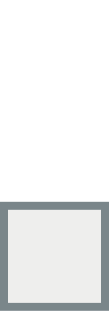
105 x 105 mm

A6

105 x 210 mm

105 x 297 mm

120 x 120 mm

148 x 148 mm
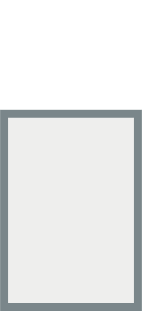
A5

160 x 160 mm

183 x 273 mm DVD

210 x 210 mm

A4

A3

A7

75 x 210 mm

105 x 105 mm

A6
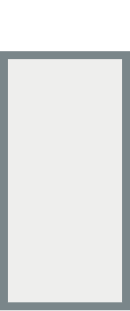
105 x 210

105 x 297

120 x 120 mm

A5

A4

100 x 210 mm
Types of folds
For your folded leaflets you can choose from numerous fold types such as gate fold, cross fold, gate fold, fanfold, spiral fold and parallel centre fold. In addition, it is possible to combine some of these fold types and thus have folded leaflets printed with up to 36 pages.
Please note that certain types of folds are only available from a certain format and, for quality reasons, only from a certain grammage (paper thickness).

1-break fold
The simplest type of fold with only one fold or break is the 1-break fold. It is also called single fold and is folded exactly once in the middle. This type of fold produces a 4-page flyer. 1-break folded leaflets are particularly suitable for folded cards such as vouchers or greeting cards.

Letter Fold
With the letter fold, all folds go in the same direction and all sides are "wrapped" around one. The simplest form of the letter fold has two folds and these result in a flyer with 6 pages. Depending on the format, menu cards or event information can be ideally accommodated in a letter fold flyer. If 6 pages are not enough, you still have the option of having a 3-break letter fold flyer with 8 pages printed.

Zig-zag Fold
The Zig zag fold is also called Z-fold and results in a 6-page flyer with at least 2 folds. The pages are folded alternately in the opposite direction of the last break. With high-quality zigzag flyers in DIN A6 format and special finishes, you can impress your customers with new product information. You can also have zig zag folded leaflets printed by us with 8 pages (3 folds), 10 pages (4 folds) or 12 pages (5 folds).

Parallel fold
The Centre fold is also called double parallel fold or 2-break parallel fold and is merely an extension of the single-fold. The paper sheet is folded twice in succession in the same direction in the middle. This creates 3 fold lines and you get an 8-page flyer. You can also have a 3-break parallel fold flyer printed with 16 pages. In DIN long format, parallel centre folded leaflets offer enough space for an extensive event programme.

3-break Letter Fold
In contrast to the simple letter fold with 2 breaks, the 3-break letter fold has 3 breaks, resulting in a flyer with 8 pages. This means that even more information can be placed on a 3-break letter fold flyer than on a simple letter fold flyer.

3-break Zig-zag Fold
As the name suggests, a 3-break zig zag fold flyer has one more break than a classic zig zag fold flyer. This means that a 3-part zig zag fold flyer with 8 pages can contain even more information.

Double-gate Fold
For an 8-page double gatefold flyer, the two outer sides are first folded inwards so that the outer edges lie against each other in the middle (6-sided gatefold). Then the flyer is folded in the middle so that the two outer edges are on the inside and all three fold breaks go in the same direction. The 3-fold double gatefold flyer offers plenty of space for extensive information on events or new products, especially in DIN-A4 format.

French Fold
For a French fold, the flyer is folded once lengthwise and once crosswise. The fold edges form a cross. The simplest cross fold with 2 breaks results in 8 pages. This type of fold is particularly suitable for posters and maps.

4-break Zig-zag Fold
With a 4-break zig zag folded leaflet, 4 folds give you a total of 10 pages. This allows you to place even more information on a 4-fold zig-zag folded leaflet.

3-break parallel fold
In a 3-break parallel fold, a sheet of paper is folded three times in a row in the same direction in the middle. The resulting 7 fold lines result in 16 pages that offer plenty of space for extensive information.
Which paper may it be for your flyers?
There are different paper options available for flyer printing. The standard are flyers made of coated art paper, which are available in thicknesses of 90 to 350 gsm. If your flyers are to be very sturdy and stable, for example for Leporellos or bonus cards, we also offer 250 gsm strong coated board premium. Coated art paper for flyers has the advantage that photos and other graphics can be printed with high brilliance and depth. In addition, you have the choice between matt or glossy paper.
For exclusive invitations, premium papers are the right choice. At print24.com you can choose between the versions Chamois, ribbed, linen and bright white. Ribbed or linen-textured premium papers offer a pleasing look in addition to a very special feel. Flyers made of fine paper can be produced in thinner paper between 100 and 130 gsm and thicker paper between 300 and 350 gsm.
The thinner premium papers have the advantage that you can even further process them yourself with a printer or copier.
This option is also available for flyers made of offset paper in five thicknesses from 80 to 170 gsm. In particular, large quantities of flyers can be produced at a very low price with this inexpensive paper. The paper is also available in thicknesses of 350 and 400 gsm. For environmentally-conscious customers, we offer flyers made of recycled paper. The white paper is made from 100% recycled paper and has the "Blue Angel" seal. It is configurable in thicknesses of 80 to 300 gsm. If you want to print robust customer cards or stamp cards as flyers, the chromo board is recommended. Its uncoated back can be written on with conventional pens.
With its slightly structured surface, the groundwood pulp board is particularly suitable for printing. The unusual material has a thickness of 1.4 mm with a grammage of 575 gsm. This cardboard is made of shredded wood with a slightly yellowish colour, which is caused by the amount of lignin in the cardboard. This makes your flyers particularly stable.
Our felt-marked uncoated paper has a classic hand-made structure. It has a pleasant, soft feel, is FSC® certified and made from pure ECF pulp (elemental chlorine free). The characteristic elegant surface structure inspires a wide range of applications.
We offer grass paper as a "green" natural paper. It is an environmentally friendly alternative in its production, in which the proportion of grass fibres can be up to 40%, depending on the intended use. The natural-coloured material has a textured, tactile surface. The inherent colouring of the paper can influence the colours printed on it.
The particularly strong kraft paper has a high tensile strength due to the long cellulose fibres it contains. Our kraft paper is white on the front and natural brown on the back. Due to its open-pored surface, printing inks are absorbed more strongly. This makes the print result less radiant than on coated paper. On the other hand, unlike most other papers, it is water-repellent to a certain extent.
STAFIX®STATIC is an adhesive-free 50 micron thick polypropylene film that adheres to virtually all clean smooth surfaces by means of a static charge. The material is easy to apply and remove without leaving any residue.
Refinements
With a finishing you can turn a simple flyer into something very special. At print24.com you can choose from many different options. For example, blind embossing can optimise the haptic impression of your flyer. Individual areas or lettering as well as characters are embossed into the paper. When choosing this finishing, please note that it is only possible from a certain paper thickness.
Of course, you can also finish the entire surface of your flyer. Cellophaning, also called lamination, is suitable for this. We apply a very thin film to the paper. This not only makes the flyer more visually appealing in matt or glossy, but also gives it additional protection. Lamination is recommended for grammages of 170 gsm and above. To use hot foil stamping, your chosen paper must also be stronger. This is because not only is gold or silver foil applied, but it is also embossed. With hot foil relief embossing, you also create an extraordinary three-dimensionality that can, for example, make motifs look even more sculpted.
As a special highlight, we offer the possibility of applying a foil in gold, rose gold or silver with digital foil. The process does not require an embossing die and can therefore also be used for a small print run. The foil is applied using a special chrome roller. It is in no way inferior to hot foil stamping and enables metallic effects even in gradations.
In addition to foils, we can also apply varnish to finish your flyers. The application is possible both as relief varnish and in the form of UV surface varnish as well as UV spot varnish. If you have any further questions about the finishing options we offer, please do not hesitate to contact us. We are personally available on the phone to answer your questions.
Tip: You can also have your flyers folded, grooved or perforated. In this way, the print products can be used for detachable vouchers or other promotional flyers. Grooving is particularly recommended for paper thicknesses of 170 gsm and above to prevent the top layers of paper from cracking. From a paper choice of 250 gsm onwards, we will automatically groove your product.
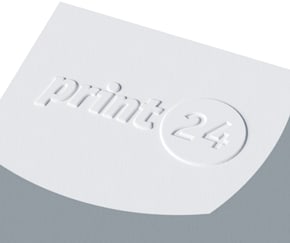
Blind embossing
With blind embossing, you can highlight a motif vividly. If you choose a high embossing, your motif will be displayed in a raised position, if you choose a deep embossing, the motif will be imprinted as a dent in your printed product.
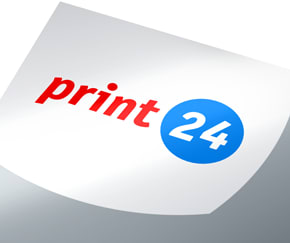
Cellophane coating
With laminating, a wafer-thin film is applied to your printed product. This gives your printed product a higher quality and at the same time makes it more robust.
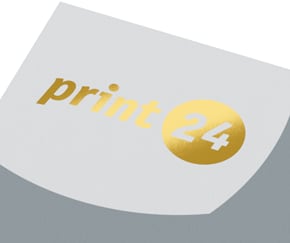
Hot foil stamping
Hot foil stamping uses pressure and heat to apply coatings from a carrier foil to your printed product. This allows you to enhance your print product with metallic effects, for example.
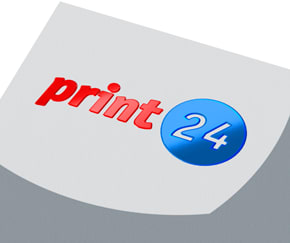
Relief varnish
With relief varnish you can highlight certain areas of your printed product both visually and haptically, these are printed glossy and elevated.
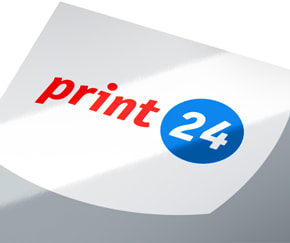
UV surface varnish
With UV surface varnishing, an additional layer of varnish is applied to your printed product, which gives it additional protection and makes it look even higher quality.
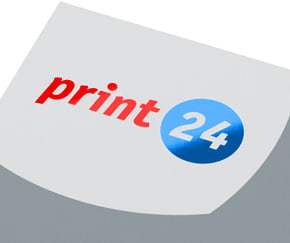
UV spot varnish
With UV spot varnishing, the varnish is applied only partially. This allows you to highlight certain areas of your product both visually and haptically.
We would be happy to create further printed products such as Letterheads, Personalised business cards or Brochures for you!

Frequently asked questions about our flyers
What is the paper selection for the flyers? Which paper do the flyers consist of?
For flyers we offer bright white coated art papers. All offset papers are bright white and suitable for copying and laser printing. Our bright white recycled paper is FSC-certified and has the Blue Angel environmental seal. You can also choose from our special premium papers (chamois, ribbed, bright white, linen). We offer all types of paper in different paper thicknesses and grammages. Most flyers are ordered with 135 gsm picture printing paper.
Which flyer formats are available at print24?
Which format is right for you depends on the amount of your information, the purpose and the target group of your flyer. In the selection box of the configuration menu you can see what we offer for standard formats. From A3 to A8 as well as intermediate sizes and square or long flyer formats, everything is represented. Your desired format is not included? Then click on "Special format" in the configuration menu to the right of "Format" and define your special format. Make sure that your format is within the standard dimensions of 52 x 52 mm and 297 x 420 mm.
What is the difference between a leaflet and a flyer?
Flyers are 1-sided, leaflets have at least 2 sides and are folded. The number of pages always refers to the processed (e.g. folded) finished flyers in their final state. Please note that certain types of folds are only offered from a certain grammage due to their quality (e.g. altar folds from 170 gsm).
How much do 1.000 flyers cost?
That all depends on how many pages, which format and paper you have selected and whether you want a refinement. 1,000 pieces of our A6 flyer (with 135 gsm picture printing paper, untreated, 4-colour print and 2-sided) can be obtained for only £14.91 including shipping and VAT. Simply select from the configuration menu which features your flyer should have, the price is always updated when you change a setting and is clearly visible next to the shipping price.
How long do I have to wait for my flyers to arrive?
Select between Economy, Standard, Express or Priority delivery time options. The estimated delivery time is displayed directly in the configuration menu. Please note, however, that the delivery time of your flyers also depends on selected extras and quantity. With our fastest shipping method - Priority Shipping - you can receive your flyers within 24 hours (for an additional charge).
Which trim do I have to consider with flyers?
The bleed allowance for flyers is 2 mm on each side. Nevertheless, the print file should not go exactly to the bleed edge, but beyond it. This avoids the unavoidable irregularities that can result from cutting and punching. But do not place important elements and lettering too close to the bleed edge so that they are not trimmed.
What does "Print flyer with spot colour" mean? What is Pantone?
As standard printing inks, we offer four-colour printing in CMYK. Cyan, magenta and yellow are the basic colours of subtractive colour mixing. Black must be added, as it is not possible to produce pure black from these basic colours. Pantone is a colour system for spot and process colours. They are specially mixed and do not consist of the standard process colours cyan, magenta, yellow or black. Each spot colour results in an additional colour separation for printing. The individual spot colours can be determined with the aid of colour guides and colour tables. The Pantone colour system is used for gold and silver. However, the metallic effect can only be guaranteed with 100% ink application. Graduations in the colours lead to a loss. For Pantone colours, a separate colour channel must be created when creating the print data for the corresponding objects.
Please always create the spot colors in a separate spot color channel and label it according to the spot color you have ordered. Only the ordered tone can be printed.
Can standard and special colours be combined for flyers?
With print24, monochrome and CMYK four-colour printing can be combined with Pantone inks. If you would like to print in spot colours, then select a spot colour combination in the "Print" selection box and select your desired colour tone, for example 5/5-colour CMYK + gold.
What should you pay attention to when designing the flyer?
Create your flyers with us in the FreeDesign-Tool or with Photoshop, InDesign etc. at your place. Make sure to include the bleed and to create the print data at least in 300dpi as PDF, JPEG or TIFF in CMYK colour mode with the colour profile "ISO Coated v2 (Fogra 39 L)" for coated art paper and "PSO Uncoated ISO12647 (Fogra 47L)" for offset or recycling paper.
Can I view my finished flyer before printing?
The "Screenproof" option gives you the opportunity (for a small surcharge) to see for yourself how your flyer will look before printing. This means that you can preview your product in your MyOrders folder in the print24 customer account in a resolution of 150 dpi. The preview of the screen proofs is not colourfast, deviations are possible. If you would like to see the actual colouring of the flyer in advance, select the "Paperproof" option. In this case, we will send you a colour-binding, Fogra-certified pre-print of your flyer on the next working day. The costs for a paper proof as well as the delivery time will be displayed directly online during the selection process.